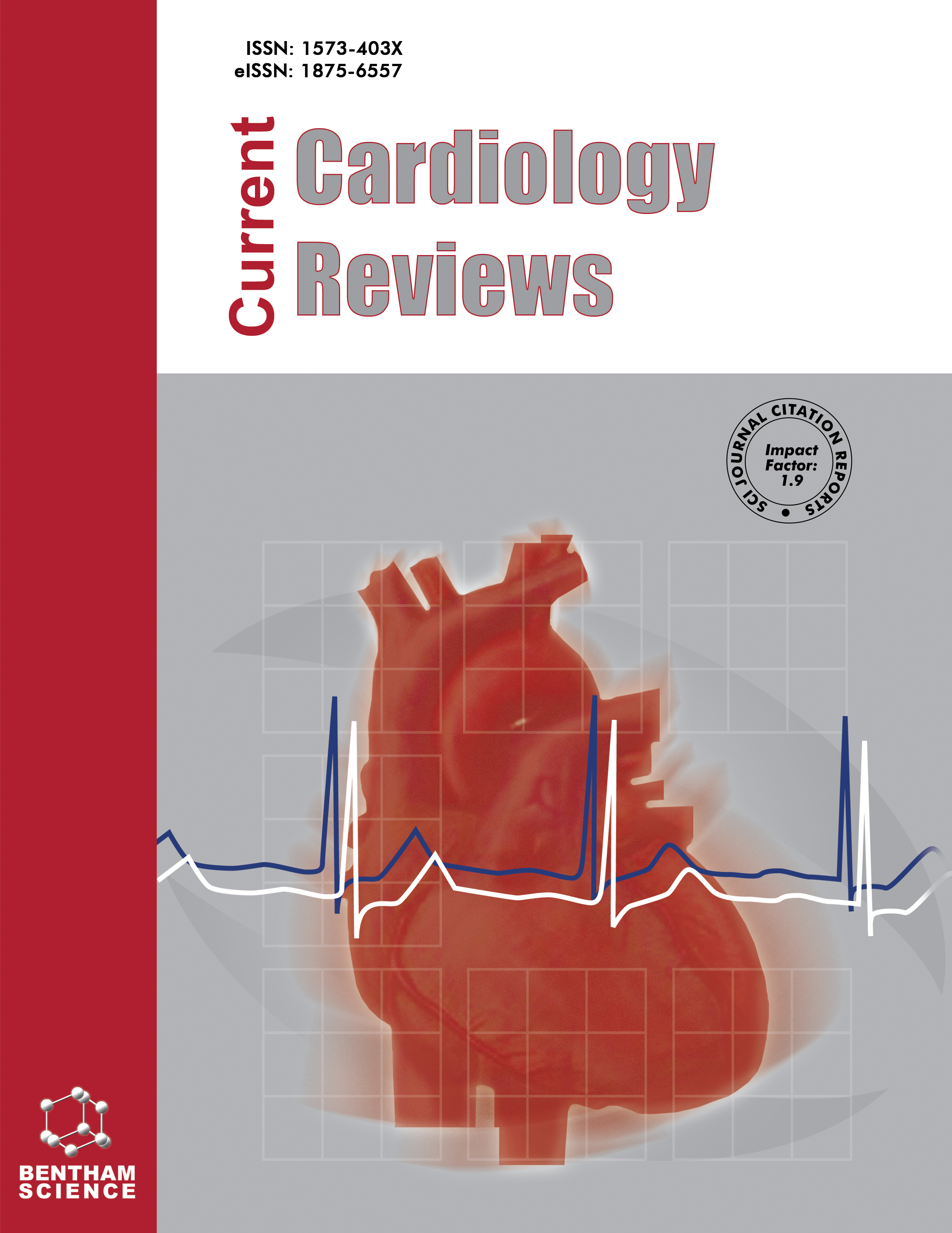- Home
- A-Z Publications
- Current Cardiology Reviews
- Previous Issues
- Volume 8, Issue 3, 2012
Current Cardiology Reviews - Volume 8, Issue 3, 2012
Volume 8, Issue 3, 2012
-
-
Pathophysiology of Coronary Thrombus Formation and Adverse Consequences of Thrombus During PCI
More LessAuthors: Sundararajan Srikanth and John A. AmbroseAtherosclerosis is a systemic vascular pathology that is preceded by endothelial dysfunction. Vascular inflammation "fuels" atherosclerosis and creates the milieu for episodes of intravascular thromboses. Thrombotic events in the coronary vasculature may lead to asymptomatic progression of atherosclerosis or could manifest as acute coronary syndromes or even sudden cardiac death. Thrombus encountered in the setting Read More
-
-
-
Facilitated/Pharmaco-invasive Approaches in STEMI
More LessAuthors: Davide Capodanno and George DangasPrimary percutaneous coronary intervention (PCI) is the preferred reperfusion method in patients with STelevation myocardial infarction (STEMI), when performed in a timely manner and by skilled operators. However, this strategy has shown to be limited in environments with lack of PCI facilities and delay in the first medical contact-toballoon time for logistic reasons. Pretreatment with fibrinolysis and/or glycoprotein IIb/II Read More
-
-
-
Appropriate Anti-Thrombotic/Anti-Thrombin Therapy for Thrombotic Lesions
More LessAuthors: Zafar Iqbal, Gurinder Rana and Marc CohenManaging coronary thrombus is a challenging task and requires adequate knowledge of the various antithrombotic agents available. In this article, we will briefly analyze the risk-benefit profile of antithrombotic agents, with critical analysis of the scientific evidence available to support their use. Since thrombus consists of platelets and coagulation cofactors, an effective antithrombotic strategy involves using one anticoagulant wit Read More
-
-
-
Embolic Protection Devices in Saphenous Vein Graft and Native Vessel Percutaneous Intervention: A Review
More LessAuthors: Eron Sturm, David Goldberg and Sheldon GoldbergThe clinical benefit of percutaneous intervention (PCI) depends on both angiographic success at the site of intervention as well as the restoration of adequate microvascular perfusion. Saphenous vein graft intervention is commonly associated with evidence of distal plaque embolization, which is correlated with worse clinical outcomes. Despite successful epicardial intervention in the acute MI patient treated with primary PCI, dista Read More
-
-
-
Thrombus Extraction Catheters vs. Angiojet Rheolytic Thrombectomy in Thrombotic Lesions/SV Grafts
More LessAuthors: Dimitrios Alexopoulos and Periklis A. DavlourosPrimary percutaneous coronary intervention, (pPCI), of native coronaries and saphenous vein grafts (SVGs), is the recommended reperfusion strategy for STEMI, and an early invasive approach is recommended for high risk patients with UA/NSTEMI. Although PCI effectively restores flow in the infarct related artery/culprit vessel in both situations, myocardial perfusion often remains suboptimal due to microvascular obstructi Read More
-
-
-
Treating and Preventing No Reflow in the Cardiac Catheterization Laboratory
More LessAuthors: Ryan Berg and Cyrus BuhariThe no reflow phenomenon can happen during elective or primary percutaneous coronary intervention. This phenomenon is thought to be a complex process involving multiple factors that eventually lead to microvascular obstruction and endothelial disruption. Key pathogenic components include distal atherothrombotic embolization, ischemic injury, reperfusion injury, and susceptibility of coronary microcircula Read More
-
-
-
Standard Terminologies for Photoplethysmogram Signals
More LessPhotoplethysmography is one of the optical techniques has been developed for experimental use in vascular disease. It has several advantages over other traditional experimental approaches. Because of its non-invasive, safe, costeffective and easy-to-use properties, it is considered as a useful diagnostic tool. The further developments in the Photoplethysmograph may replace it among other tools used in the assessment Read More
-
-
-
Systems Biology and Biomechanical Model of Heart Failure
More LessAuthors: George E. Louridas and Katerina G. LouridaHeart failure is seen as a complex disease caused by a combination of a mechanical disorder, cardiac remodeling and neurohormonal activation. To define heart failure the systems biology approach integrates genes and molecules, interprets the relationship of the molecular networks with modular functional units, and explains the interaction between mechanical dysfunction and cardiac remodeling. The biomechanical mod Read More
-
-
-
Frequency Domain Mapping of Atrial Fibrillation - Methodology, Experimental Data and Clinical Implications
More LessAuthors: Vassil B. Traykov, Robert Pap and Laszlo SaghyThe concept of dominant frequency (DF) has been used as a way to express local atrial activation rate during atrial fibrillation (AF). The rotor theory explaining the pathophysiology of AF is widely based upon spatial distribution of DF in the atria. Using frequency domain analysis to represent the rate of atrial activation by DF can avoid some of the limitations of time domain analysis of signals during AF. Understanding the concept Read More
-
-
-
Antiplatelet and Antithrombin Strategies in Acute Coronary Syndrome: State-Of-The-Art Review
More LessAuthors: Refai Showkathali and Arun NatarajanAntiplatelet and antithrombotic agents significantly alter the clinical course of patients with acute coronary syndrome (ACS) and hence form the bedrock of the management pathway of this closely related continuum of coronary pathologies. The contemporary therapeutic armamentarium for the treatment of ACS now reflects the many technical and pharmacological advances that took place over the last two decades. In the o Read More
-
Volumes & issues
-
Volume 21 (2025)
-
Volume 20 (2024)
-
Volume 19 (2023)
-
Volume 18 (2022)
-
Volume 17 (2021)
-
Volume 16 (2020)
-
Volume 15 (2019)
-
Volume 14 (2018)
-
Volume 13 (2017)
-
Volume 12 (2016)
-
Volume 11 (2015)
-
Volume 10 (2014)
-
Volume 9 (2013)
-
Volume 8 (2012)
-
Volume 7 (2011)
-
Volume 6 (2010)
-
Volume 5 (2009)
-
Volume 4 (2008)
-
Volume 3 (2007)
-
Volume 2 (2006)
-
Volume 1 (2005)
Most Read This Month
Article
content/journals/ccr
Journal
10
5
false
en


